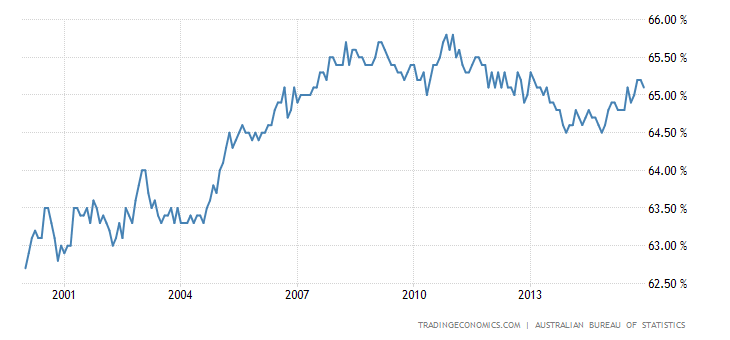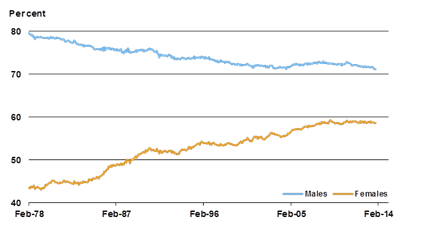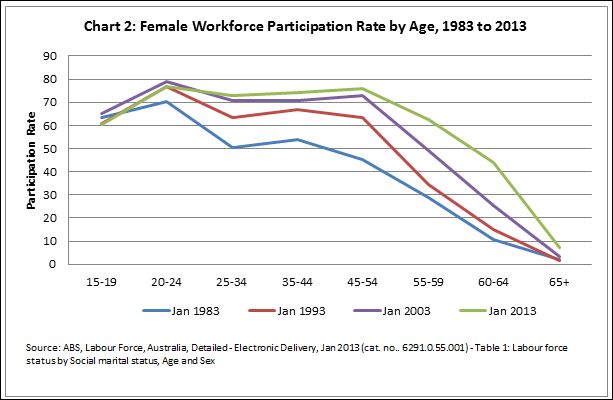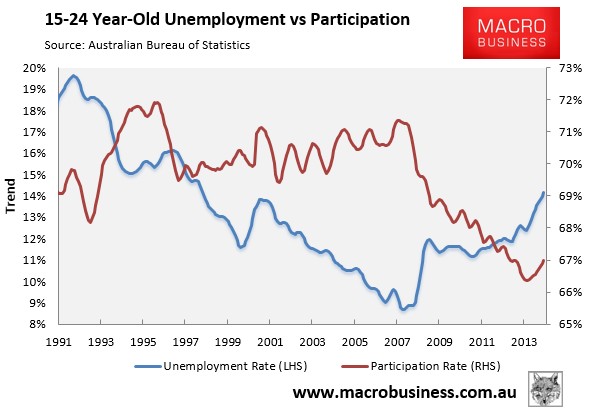RM provides a broader and deeper analysis of employment data than ABS stats
No they don't.
Roy Morgan surveys approx. 5,000 people each month.
The ABS surveys approx. 50,000 people each month.
So straight away we can see the ABS sample size is ten times that of Roy Morgan.
Also, the ABS provides a much more detailed analysis of the data, including all the tables listed below every month...
http://www.abs.gov.au/ausstats/[email protected]/mf/6202.0
Labour Force Commentary November 2014
what's new in the labour force
Independent Technical Review into the Labour Force Survey and ABS Response
Article Archive
About this Release
Labour Force, Australia (Media Release)
Explanatory Notes
Downloads
Table 01. Labour force status by Sex - Trend Download Excel File (772 kB)Download Zip File (405 kB)
Table 02. Labour force status by Sex - Seasonally adjusted Download Excel File (772 kB)Download Zip File (406 kB)
Table 03. Labour force status by Sex Download Excel File (873 kB)Download Zip File (462 kB)
Table 04. Labour force status by Sex - New South Wales - Trend, Seasonally adjusted and Original Download Excel File (718 kB)Download Zip File (373 kB)
Table 05. Labour force status by Sex - Victoria - Trend, Seasonally adjusted and Original Download Excel File (717 kB)Download Zip File (373 kB)
Table 06. Labour force status by Sex - Queensland - Trend, Seasonally adjusted and Original Download Excel File (717 kB)Download Zip File (373 kB)
Table 07. Labour force status by Sex - South Australia - Trend, Seasonally adjusted and Original Download Excel File (717 kB)Download Zip File (372 kB)
Table 08. Labour force status by Sex - Western Australia - Trend, Seasonally adjusted and Original Download Excel File (717 kB)Download Zip File (372 kB)
Table 09. Labour force status by Sex - Tasmania - Trend, Seasonally adjusted and Original Download Excel File (717 kB)Download Zip File (372 kB)
Table 10. Labour force status by Sex - Northern Territory - Trend and Original Download Excel File (461 kB)Download Zip File (234 kB)
Table 11. Labour force status by Sex - Australian Capital Territory - Trend and Original Download Excel File (461 kB)Download Zip File (234 kB)
Table 12. Labour force status by Sex - States and Territories Download Excel File (4393 kB)Download Zip File (1922 kB)
Table 13. Labour force status by Sex - Persons aged 15 to 19 years - Trend Download Excel File (617 kB)Download Zip File (318 kB)
Table 14. Labour force status by Sex - Persons aged 15 to 19 years - Seasonally adjusted Download Excel File (618 kB)Download Zip File (319 kB)
Table 15. Labour force status by Sex and Educational attendance - Persons aged 15 to 19 years Download Excel File (3917 kB)Download Zip File (1068 kB)
Table 16. Labour force status by Educational attendance, States and Territories - Persons aged 15 to 19 years Download Excel File (22480 kB)Download Zip File (4324 kB)
Table 17. Labour force status by Sex - Persons aged 15 to 24 years - Trend, Seasonally adjusted and Original Download Excel File (2099 kB)Download Zip File (1123 kB)
Table 18. Labour force status by Sex - Persons aged 15 to 64 years - Trend, Seasonally adjusted and Original Download Excel File (2081 kB)Download Zip File (1117 kB)
Table 19. Aggregate monthly hours worked by Employment Status and Sex - Trend and Seasonally adjusted Download Excel File (460 kB)Download Zip File (236 kB)
Table 20. Aggregate monthly hours worked by State - Trend and Seasonally adjusted Download Excel File (403 kB)Download Zip File (202 kB)
Table 21. Quarter measure of aggregate monthly hours worked by Industry Sector - Seasonally adjusted Download Excel File (170 kB)Download Zip File (84 kB)
Table 22. Labour underutilisation by Age and Sex - Trend, Seasonally adjusted and Original Download Excel File (1430 kB)Download Zip File (608 kB)
Table 23. Labour underutilisation by State and Sex - Trend, Seasonally adjusted and Original Download Excel File (1893 kB)Download Zip File (793 kB)
All Time Series Spreadsheets
With each of the spreadsheets covering information such as...
Employed - full-time ; Males ;
Employed - full-time ; Females ;
Employed - full-time ; Persons ;
Employed - part-time ; Males ;
Employed - part-time ; Females ;
Employed - part-time ; Persons ;
Employed - total ; Males ;
Employed - total ; Females ;
Employed - total ; Persons ;
Unemployed - looking for full-time work ; Males ;
Unemployed - looking for full-time work ; Females ;
Unemployed - looking for full-time work ; Persons ;
Unemployed - looking for part-time work ; Males ;
Unemployed - looking for part-time work ; Females ;
Unemployed - looking for part-time work ; Persons ;
Unemployed - total ; Males ;
Unemployed - total ; Females ;
Unemployed - total ; Persons ;
Labour Force ; Males ;
Labour Force ; Females ;
Labour Force ; Persons ;
Unemployment rate - looking for full-time work ; Males ;
Unemployment rate - looking for full-time work ; Females ;
Unemployment rate - looking for full-time work ; Persons ;
Unemployment rate ; Males ;
Unemployment rate ; Females ;
Unemployment rate ; Persons ;
Participation rate ; Males ;
Participation rate ; Females ;
Participation rate ; Persons ;
Employment to population ratio ; Males ;
Employment to population ratio ; Females ;
Employment to population ratio ; Persons ;
Unemployment to population ratio - looking for full time work ; Males ;
Unemployment to population ratio - looking for full time work ; Females ;
Unemployment to population ratio - looking for full time work ; Persons ;
Underemployed workers ; 15 - 24 ; Males ;
Underemployed workers ; 15 - 24 ; Females ;
Underemployed workers ; 15 - 24 ; Persons ;
Underemployed workers ; 25 - 34 ; Males ;
Underemployed workers ; 25 - 34 ; Females ;
Underemployed workers ; 25 - 34 ; Persons ;
Underemployed workers ; 35 - 44 ; Males ;
Underemployed workers ; 35 - 44 ; Females ;
Underemployed workers ; 35 - 44 ; Persons ;
Underemployed workers ; 45 - 54 ; Males ;
Underemployed workers ; 45 - 54 ; Females ;
Underemployed workers ; 45 - 54 ; Persons ;
Underemployed workers ; 55 and over ; Males ;
Underemployed workers ; 55 and over ; Females ;
Underemployed workers ; 55 and over ; Persons ;
Underemployed workers ; Total (Age) ; Males ;
Underemployed workers ; Total (Age) ; Females ;
Underemployed workers ; Total (Age) ; Persons ;
Underemployment rate ; 15 - 24 ; Males ;
Underemployment rate ; 15 - 24 ; Females ;
Underemployment rate ; 15 - 24 ; Persons ;
Underemployment rate ; 25 - 34 ; Males ;
Underemployment rate ; 25 - 34 ; Females ;
Underemployment rate ; 25 - 34 ; Persons ;
Underemployment rate ; 35 - 44 ; Males ;
Underemployment rate ; 35 - 44 ; Females ;
Underemployment rate ; 35 - 44 ; Persons ;
Underemployment rate ; 45 - 54 ; Males ;
Underemployment rate ; 45 - 54 ; Females ;
Underemployment rate ; 45 - 54 ; Persons ;
Underemployment rate ; 55 and over ; Males ;
Underemployment rate ; 55 and over ; Females ;
Underemployment rate ; 55 and over ; Persons ;
Underemployment rate ; Total (Age) ; Males ;
Underemployment rate ; Total (Age) ; Females ;
Underemployment rate ; Total (Age) ; Persons ;
Labour force underutilisation rate ; 15 - 24 ; Males ;
Labour force underutilisation rate ; 15 - 24 ; Females ;
Labour force underutilisation rate ; 15 - 24 ; Persons ;
Labour force underutilisation rate ; 25 - 34 ; Males ;
Labour force underutilisation rate ; 25 - 34 ; Females ;
Labour force underutilisation rate ; 25 - 34 ; Persons ;
Labour force underutilisation rate ; 35 - 44 ; Males ;
Labour force underutilisation rate ; 35 - 44 ; Females ;
Labour force underutilisation rate ; 35 - 44 ; Persons ;
Labour force underutilisation rate ; 45 - 54 ; Males ;
Labour force underutilisation rate ; 45 - 54 ; Females ;
Labour force underutilisation rate ; 45 - 54 ; Persons ;
Labour force underutilisation rate ; 55 and over ; Males ;
Labour force underutilisation rate ; 55 and over ; Females ;
Labour force underutilisation rate ; 55 and over ; Persons ;
Labour force underutilisation rate ; Total (Age) ; Males ;
Labour force underutilisation rate ; Total (Age) ; Females ;
Labour force underutilisation rate ; Total (Age) ; Persons ;
Underemployed workers ; 15 - 24 ; Males ;
Underemployed workers ; 15 - 24 ; Females ;
Underemployed workers ; 15 - 24 ; Persons ;
Underemployed workers ; 25 - 34 ; Males ;
Underemployed workers ; 25 - 34 ; Females ;
Underemployed workers ; 25 - 34 ; Persons ;
Underemployed workers ; 35 - 44 ; Males ;
Underemployed workers ; 35 - 44 ; Females ;
Underemployed workers ; 35 - 44 ; Persons ;
Underemployed workers ; 45 - 54 ; Males ;
Underemployed workers ; 45 - 54 ; Females ;
Underemployed workers ; 45 - 54 ; Persons ;
Underemployed workers ; 55 and over ; Males ;
Underemployed workers ; 55 and over ; Females ;
Underemployed workers ; 55 and over ; Persons ;
Underemployed workers ; Total (Age) ; Males ;
Underemployed workers ; Total (Age) ; Females ;
Underemployed workers ; Total (Age) ; Persons ;
Underemployment rate ; 15 - 24 ; Males ;
Underemployment rate ; 15 - 24 ; Females ;
Underemployment rate ; 15 - 24 ; Persons ;
Underemployment rate ; 25 - 34 ; Males ;
Underemployment rate ; 25 - 34 ; Females ;
Underemployment rate ; 25 - 34 ; Persons ;
Underemployment rate ; 35 - 44 ; Males ;
Underemployment rate ; 35 - 44 ; Females ;
Underemployment rate ; 35 - 44 ; Persons ;
Underemployment rate ; 45 - 54 ; Males ;
Underemployment rate ; 45 - 54 ; Females ;
Underemployment rate ; 45 - 54 ; Persons ;
Underemployment rate ; 55 and over ; Males ;
Underemployment rate ; 55 and over ; Females ;
Underemployment rate ; 55 and over ; Persons ;
Underemployment rate ; Total (Age) ; Males ;
Underemployment rate ; Total (Age) ; Females ;
Underemployment rate ; Total (Age) ; Persons ;
Labour force underutilisation rate ; 15 - 24 ; Males ;
Labour force underutilisation rate ; 15 - 24 ; Females ;
Labour force underutilisation rate ; 15 - 24 ; Persons ;
Labour force underutilisation rate ; 25 - 34 ; Males ;
Labour force underutilisation rate ; 25 - 34 ; Females ;
Labour force underutilisation rate ; 25 - 34 ; Persons ;
Labour force underutilisation rate ; 35 - 44 ; Males ;
Labour force underutilisation rate ; 35 - 44 ; Females ;
Labour force underutilisation rate ; 35 - 44 ; Persons ;
Labour force underutilisation rate ; 45 - 54 ; Males ;
Labour force underutilisation rate ; 45 - 54 ; Females ;
Labour force underutilisation rate ; 45 - 54 ; Persons ;
Labour force underutilisation rate ; 55 and over ; Males ;
Labour force underutilisation rate ; 55 and over ; Females ;
Labour force underutilisation rate ; 55 and over ; Persons ;
Labour force underutilisation rate ; Total (Age) ; Males ;
Labour force underutilisation rate ; Total (Age) ; Females ;
Labour force underutilisation rate ; Total (Age) ; Persons ;
Underemployed workers ; 15 - 24 ; Males ;
Underemployed workers ; 15 - 24 ; Females ;
Underemployed workers ; 15 - 24 ; Persons ;
Underemployed workers ; 25 - 34 ; Males ;
Underemployed workers ; 25 - 34 ; Females ;
Underemployed workers ; 25 - 34 ; Persons ;
Underemployed workers ; 35 - 44 ; Males ;
Underemployed workers ; 35 - 44 ; Females ;
Underemployed workers ; 35 - 44 ; Persons ;
Underemployed workers ; 45 - 54 ; Males ;
Underemployed workers ; 45 - 54 ; Females ;
Underemployed workers ; 45 - 54 ; Persons ;
Underemployed workers ; 55 and over ; Males ;
Underemployed workers ; 55 and over ; Females ;
Underemployed workers ; 55 and over ; Persons ;
Underemployed workers ; Total (Age) ; Males ;
Underemployed workers ; Total (Age) ; Females ;
Underemployed workers ; Total (Age) ; Persons ;
Underemployment rate ; 15 - 24 ; Males ;
Underemployment rate ; 15 - 24 ; Females ;
Underemployment rate ; 15 - 24 ; Persons ;
Underemployment rate ; 25 - 34 ; Males ;
Underemployment rate ; 25 - 34 ; Females ;
Underemployment rate ; 25 - 34 ; Persons ;
Underemployment rate ; 35 - 44 ; Males ;
Underemployment rate ; 35 - 44 ; Females ;
Underemployment rate ; 35 - 44 ; Persons ;
Underemployment rate ; 45 - 54 ; Males ;
Underemployment rate ; 45 - 54 ; Females ;
Underemployment rate ; 45 - 54 ; Persons ;
Underemployment rate ; 55 and over ; Males ;
Underemployment rate ; 55 and over ; Females ;
Underemployment rate ; 55 and over ; Persons ;
Underemployment rate ; Total (Age) ; Males ;
Underemployment rate ; Total (Age) ; Females ;
Underemployment rate ; Total (Age) ; Persons ;
Labour force underutilisation rate ; 15 - 24 ; Males ;
Labour force underutilisation rate ; 15 - 24 ; Females ;
Labour force underutilisation rate ; 15 - 24 ; Persons ;
Labour force underutilisation rate ; 25 - 34 ; Males ;
Labour force underutilisation rate ; 25 - 34 ; Females ;
Labour force underutilisation rate ; 25 - 34 ; Persons ;
Labour force underutilisation rate ; 35 - 44 ; Males ;
Labour force underutilisation rate ; 35 - 44 ; Females ;
Labour force underutilisation rate ; 35 - 44 ; Persons ;
Labour force underutilisation rate ; 45 - 54 ; Males ;
Labour force underutilisation rate ; 45 - 54 ; Females ;
Labour force underutilisation rate ; 45 - 54 ; Persons ;
Labour force underutilisation rate ; 55 and over ; Males ;
Labour force underutilisation rate ; 55 and over ; Females ;
Labour force underutilisation rate ; 55 and over ; Persons ;
Labour force underutilisation rate ; Total (Age) ; Males ;
Labour force underutilisation rate ; Total (Age) ; Females ;
Labour force underutilisation rate ; Total (Age) ; Persons ;






